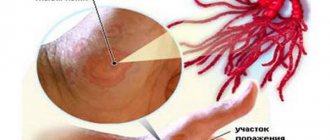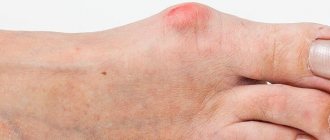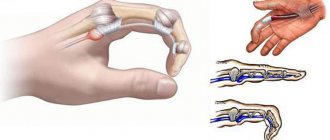Signs of a fracture
External signs suggest a finger fracture:
swelling of soft tissues;
skin hyperemia in the area of injury;
formation of hematoma, hemorrhage;
impaired mobility of the interphalangeal joint;
pain of varying intensity.
At the moment of injury, sharp pain immediately occurs in the fracture area. This is due to the fact that the connective tissue film (periosteum) that surrounds the bone contains many nerve endings. Violation of its integrity leads to the development of pain. Their severity depends on the location of the injury and the type of fracture (crack, displacement of bone fragments). At rest, the pain can be severe and constant, or vice versa, it subsides. Any movement of a finger or foot leads to its intensification.
Fractures are accompanied by swelling of soft tissues ─ muscles, subcutaneous tissue, dermis. This is due to the release of internal fluids ─ lymph and blood plasma into the intercellular space. When vessels are compressed, the following types of vascular pressure are disrupted:
osmotic ─ tissue strength decreases, the permeability of vascular walls increases, biochemical processes are disrupted;
hydrostatic ─ the force acting on the liquid in the vessels decreases, the pressure on their walls increases, and ensures the release of fluid from the capillaries;
oncotic ─ the release of plasma proteins is accelerated due to increased vascular permeability.
Imbalance of intravascular pressure leads to disruption of microcirculation, release of fluids, and the formation of edema and swelling.
The periosteum is abundantly penetrated by a blood network. Therefore, in case of a fracture with damage to the connective film, extensive diffuse hemorrhages under the skin are observed. Bruising most often occurs on the side (lateral) side, less often on the plantar surface.
Against the background of local changes, an acute inflammatory process forms within a few minutes. The site of injury is hot to the touch, the skin is reddened.
The victim places the limb in a forced position. The function of the leg as a whole is impaired. A person cannot fully stand on his foot; when walking (if possible), the center of support is transferred to the heel, while the toes are slightly raised and do not touch the ground.
Objective symptoms
Signs of a toe fracture that can help make a preliminary diagnosis before receiving the X-ray results:
pathological mobility of the phalanges of the fingers, joints;
the appearance of crunching (crepitus) of bone fragments when pressing on the site of injury;
unnatural position of the foot, change in configuration relative to the axis;
shortening or lengthening of the finger.
Finger deformation is associated not only with displacement of bone fragments. Nearby formations may be involved in the pathological process. A fracture is often accompanied by dislocation of the interphalangeal joint, damage to ligaments and tendons.
Bone crepitus occurs during palpation of the injured finger. It is heard when bone fragments rub against each other. This symptom appears only in the early stages after injury; during the healing process, the crunching noise disappears during friction.
Symptoms of toe fractures
Symptoms that occur with toe fractures depend on the nature and location of the fracture
Symptoms of broken toes may vary from person to person. In some cases, a person’s ability to move freely is preserved, in others it is sharply limited and affects overall capacity.
Factors that may influence symptoms include the following:
- severity of the fracture;
- presence of displacement (bone moving out of its correct anatomical position);
- nature of the fracture;
- the location of the fracture (the location of the joints near the fracture is of particular importance);
- having other medical conditions such as gout or arthritis.
The nature of the fracture may vary. This may include a stress fracture, injury from an object falling on the leg, or other traumatic incidents.
Because symptoms can vary greatly from person to person and the severity of the fracture can range from mild to severe, sometimes a broken finger can be mistaken for another injury, such as a pulled muscle or a severe bruise.
Below are symptoms of common types of fractures.
Traumatic fracture (memorable incident)
A broken toe is often the result of a painful and memorable incident, such as falls or being kicked against hard objects. In medicine, these types of fractures are usually called traumatic.
A traumatic fracture can be either severe or minor. Sometimes when people get such a fracture, they hear a cracking or clicking sound. Characteristic sounds occur at the moment when the integrity of the bone is broken, but they are not observed in every case.
Symptoms from traumatic fractures usually occur immediately after the incident. These symptoms may include the following:
- pain that does not go away if you give the leg rest;
- pulsation;
- hematoma;
- edema;
- redness.
In many cases of traumatic fractures, the site of injury appears dark purple, gray, or black.
These symptoms may persist for several weeks if the fracture is not treated.
Stress fracture (prolonged exposure to crushing force on bone)
Stress fractures are typically small bone fractures that occur when the finger is subjected to repeated stress. This type of injury is associated with overuse and often affects the bones of the legs.
A stress fracture can develop over several months or years after a person begins a new activity, such as running, that places stress on the legs.
Stress fractures often occur because the toe muscles become too weak to bear the stress. Without muscle support, bones become more vulnerable to external influences. As a result, periodic overexertion causes bones to break.
Symptoms of stress fractures to the toes include the following:
- pain that occurs after physical activity, such as walking or running;
- pain that goes away when the affected area is given rest;
- soreness to touch;
- swelling without signs of bruise (hematomas, redness).
Displaced fracture
A displaced fracture is a fracture in which the damaged bone no longer occupies its correct anatomical location. Such fractures usually occur after severe injuries.
A displaced fracture sometimes causes the finger to appear crooked. In some cases, a displaced fracture breaks the skin, and people may see areas of broken bone protruding through the wound.
Classification and types of fractures
The severity of the injury and the duration of the recovery period depend on the type of fracture. More often, fractures occur under direct influence of external factors, less often under indirect influence, when force is applied at a short distance from the finger.
The damage can be closed, without violating the integrity of the skin, and open, in which soft tissue is torn. Open fractures may be accompanied by bleeding from capillaries and vessels of small and medium diameter, nerve damage with subsequent loss of sensitivity and paresis (partial paralysis) of the finger.
If there is no displacement of bone fragments during a fracture, then there are no visible signs of deformation, with the exception of swelling. When fragments of the phalanx are displaced, the appearance of the finger changes and deviates from the anatomical norm.
Incomplete injuries appear as cracks on x-rays. The fragments are not completely separated from each other. With a complete fracture, two or more fragments are formed.
Depending on how the fault line runs, phalanx fractures are classified according to the following characteristics:
splintered (from one to multiple fragments).
Anatomical and clinical features of fractures of different fingers
Each individual toe is injured to varying degrees of severity. This is due to the anatomical structure, topographic location, and size.
The most commonly diagnosed fracture is the thumb. It is located on the edge, protrudes forward, has only two phalanges, relative to the other fingers, which consist of three phalanges. Bears a significant load while walking and in a static position.
First of all, the distal (nail) phalanx is injured due to a collision with a hard object, surface, as a result of compression, impact. Sometimes there is a separation of the head (epiphysis) of the nail phalanx. A fracture of the thumb negatively affects the functionality of the entire lower limb. The patient cannot stand on his foot or rest on his heel. With complicated fractures, the activity of the leg is completely blocked.
The injury often involves damage to the joints between the two phalanges and the metatarsophalangeal joint, which connects the toe to the foot (metatarsal head).
A fracture of the second finger is characterized by damage to the nail (distal) and main (proximal) phalanx. This is a common injury that occurs with a pronounced clinical picture.
Peculiarities
A broken toe is a fairly common injury. Such frequent damage is associated with its structure and assigned functions. The big toe, unlike other toes, has two phalanges, and when walking it bears the main load (see photo 1).
photo 1
A fracture can theoretically be caused by two reasons:
- Traumatic impact;
- Pathological changes in the bone (weakening of bone tissue as a result of osteoporosis, tuberculosis and other diseases).
However, often these reasons are closely interrelated. After all, there are cases of even a minor external impact (severe bruise) that leads to a fracture. They are:
- open;
- closed;
- with offset;
- without displacement.
How to distinguish a bruise from a fracture
In the event of an injury, it is not always possible to understand what signs can be used to distinguish a fracture from a bruised toe. This is true in cases where the bone damage is minor, the pain is not sharp, and the person can partially lean on the leg.
Comparative characteristics of symptoms of toe injuries
The pain is severe, does not subside for a long time after the injury, intensifies when pressing on the finger or any movement of the leg, the functionality of the limb is significantly impaired or blocked.
Painful sensations of varying intensity decrease or disappear after a while, a person can stand on his leg, walk slowly, the functionality of the limb is partially limited, but not impaired.
Depending on the type of fracture, deformity may or may not be present.
The appearance of the finger remains within the anatomical and topographical norm.
Diffuse blood permeation of soft tissues.
Formation of bruises, hematomas.
Moderate or mild, may last several weeks.
They develop instantly, the swelling is pronounced. They pass quickly.
Treatment
The treatment method should be prescribed depending on the type of fracture. In case of an open fracture, it is necessary to perform an operation to restore the bone and fix it in a stationary position.
Then treat with antibiotics to avoid infection in the soft tissues. If there is a fracture in the nail area, first of all it is necessary to numb the injured area. Then clear it of blood clots and restore the bone.
Treatment of a toe fracture that occurs inside the joint is carried out using surgery. For its successful implementation, special knitting needles are used. After completion of treatment, it is necessary to take another x-ray to make sure that the bone has healed correctly and will not cause discomfort to the patient.
How long to wear a cast
In order for the bones to heal properly, they must be fixed in a motionless position. This is best done using a plaster cast. They harden quickly and are easily removed after completion of treatment. How long you should wear the cast depends on where the bone was broken and the type of fracture.
If the phalanx of the finger is broken, then depending on whether the fracture is closed or open, and whether surgical intervention was performed, the period of wearing the splint also depends. This time can range from two to six weeks.
How long does it take for a broken toe to heal?
A broken toe heals depending on where the injury is located. If the fracture occurred in the area of the second, third and fourth fingers, then bone restoration occurs within two to two and a half weeks.
A bone fracture in the thumb heals within three to four weeks. A sign that the finger has fused is the appearance of a growth, which can be seen with repeated x-rays.
In addition, voluntary mobility of the finger, characteristic of a fracture, completely disappears. If the bone has healed incorrectly, it can be re-folded through surgery. In this case, a special design is used, called Krishner knitting needles.
The difference between a bruise and a broken toe
Determining a fracture or bruise of a toe is not as difficult as it seems at first glance. There are several signs to look out for:
- An injured finger with a fracture is particularly painful. It does not subside over time and intensifies with palpation. A bruised toe is becoming less of a concern every hour.
- The victim may notice swelling from a broken toe only after a few days. The bruise is characterized by instant swelling, which over the next 8-12 hours significantly decreases or disappears altogether.
- You can find out whether a fracture or bruise occurs in a particular case by comparing the same toes on both feet. Deformation changes during a fracture visually make the finger smaller.
- If the integrity of the bone is broken, it is difficult to move the foot. In most cases, a bruised toe does not interfere with normal movement. The victim can call a taxi or ambulance and get to the hospital himself.
Symptoms
Due to a fracture of the big toe, the foot takes a forced position. This is immediately noticeable, and there are no problems with making a diagnosis. Symptoms of a fractured little toe are less pronounced. The leg may swell and turn blue both with a fracture and with a bruise.
What are the first signs of a broken toe? First of all, it is severe pain. It intensifies with tapping or palpation. Painful shock does not occur. Even in the case of a serious injury, pain can be tolerated. A hematoma in the area of the fracture indicates rupture of blood vessels. In some cases, the leg literally turns purple. Swelling after a fracture most often occurs with severe bruising and damage to soft tissue.
If there are wounds, then we are talking about an open injury. Skin lesions often accompany symptoms of a broken or cracked big toe. Other signs of a broken toe include:
- redness and local hyperthermia,
- increase in size of the damaged finger,
- limited mobility or complete immobility.
Symptoms of a toe fracture may include shortening of the damaged toe and its pathological mobility. If a bone is crushed, the fragments may be visible to the naked eye. Signs of a pinky toe fracture include a deformed foot and possible displacement of the fifth toe. Characteristic symptoms of a fracture of the little toe include crepitus of the bones or their fragments.
How to distinguish a fracture from a bruise
Main signs of a finger fracture
All the symptoms that make it possible to determine what exactly happened to the finger: a bruise or a fracture, can be divided into two large groups:
The first group includes the following symptoms:
- visual reduction of one finger, which was not observed before;
- deformation of the phalanx of the leg;
- upon palpation, a broken fragment or part of the bone is felt;
- the finger bends in places where it could not bend before.
The second group includes signs that do not directly indicate a fracture. This may include:
- Sharp pain in the damaged area (pain after a fracture or bruise of a finger is tolerable, the person does not lose consciousness, as is the case with fractures of other parts of the leg). This is due to two special processes. In the acute period, already in the first seconds after the injury, a sharp pain concerns the periosteum area. A few hours after the injury, the victim begins to complain of prolonged dull pain. Bursting pain concerns those cases when swelling occurs after a violation of integrity.
- Increased pain when palpating the damaged area, especially if you tap on the fingertip.
- Feeling of local temperature rising;
- Complication of movement in the damaged joint (not always);
- Severe swelling.
More about the injury
Most often, the above injury occurs as a result of severe mechanical damage (for example, unsuccessful jumps, strong falls, or receiving direct, direct blows). You should pay attention to the fact that a violation of the integrity of the phalanx bone on the leg can also be caused by reasons of internal origin.
In this case, symptoms of a toe fracture may occur due to the presence of such severe ailments as:
- bone tuberculosis;
- osteoporosis;
- metastases in the bones caused by the presence of cancer.
The above diagnosis can be caused by shoes that are too tight or an unsuccessful twisting of the foot.
Violation of the integrity of the finger is very similar, regardless of which specific finger is damaged. Since a fracture of a toe in a child is accompanied by the formation of bone elements and, accordingly, the appearance of an angle whose apex is in the lower part. This feature is associated with the anatomical structure of muscles and tendons.
Features of diagnosis and first aid for finger injuries
Important! In order to prevent the development of serious complications, the victim should immediately seek qualified help from a specialist. Thus, it is possible to select the most effective method of treatment and set of procedures for the speedy rehabilitation of the patient.
Displaced finger fracture
A closed fracture with phalangeal displacement is rare in adults. This phenomenon can only occur as a result of a very severe injury; it is also accompanied by smearing of muscles and ligaments.
Since bone tissue in children is more elastic, the displacement during a fracture in the little finger has an angular appearance. Moving to the side, ligaments and cartilage also pull bone fragments from them. Thus, timely diagnosis is difficult; the finger is relatively slightly deformed and often grows together in this position.
How to identify a violation of bone integrity if there is no displacement
When determining a fracture, doctors can immediately differentiate it in accordance with the classification accepted in medicine:
- in the direction of the fracture - oblong or transverse;
- according to the type of fracture line - screw, oblique;
- according to the fault mechanism - direct and indirect.
Of course, it is possible to make an accurate diagnosis only after an x-ray, but in order to suspect an injury, you can palpate the site of injury. First, the movements should be oblong, and then transverse and oblique.
When trying to listen to your feelings, you need to take into account that there may be several fractures, as well as the number of fragments. You can break a finger without them if you fall straight on your foot. Several fragments may occur as a result of a blunt and smooth object falling on the leg. The bone is broken into small fragments when an uneven object impacts the finger.
Bruised finger and how it manifests itself
If a fracture of a finger concerns a violation of the normal structure of the bone itself, then a bruise is a pathology that happens to soft tissues. Such an injury occurs in the event of a strong blow. In this case, the skin is not damaged. A bruised finger can occur simultaneously with a sprain or bone fracture. The main symptoms of damaged soft tissue are:
- the presence of a hematoma is a blue or even black spot that is visible from under the skin and is an accumulation of a small amount of blood;
- swelling in the damaged area;
- slight difficulty in mobility;
- pain that intensifies during palpation or movement (occurs due to pressure on the problem area of a certain amount of blood).
The condition of the victim, meanwhile, does not show significant changes. In most cases, the hematoma resolves on its own. Rarely do blood clots have to be removed solely by surgery.
According to statistics, a fracture occurs less frequently than a bruise on the little toe. How to distinguish other injuries from a broken toe can be found in medical literature or on the Internet. However, an accurate diagnosis must only be made by a traumatologist. He also deals with the treatment of all pathological changes after injury.
First aid
Lack of adequate therapy can lead to irreversible deformities. If it is not possible to quickly deliver the victim to a doctor, then you need to provide first aid for a broken toe.
In this case, the procedure will be as follows:
- give the patient a painkiller,
- treat the wound if there is one,
- fix the injured finger.
If the pain does not decrease, then non-narcotic analgesics are offered. Immobilization is necessary if displacement is suspected. You can fix your toe using a bandage and splint. Usually the thumb is immobilized. It is wrapped together with a pencil or other solid object of suitable size. Fixation is not always justified. More often, the patient is simply laid down or seated, and the leg is placed on an elevation.
If the main phalanx of the 4th finger is damaged, you can fix the finger with the adjacent one. The phalanges cannot be tied tightly; a cotton pad is placed between them. Cold will help relieve pain and swelling. Apply a bag of crushed ice for 5-10 minutes, and then take a break to avoid frostbite. Cooling will help if there is a fracture of the little toe, but for this injury, first aid will be slightly different.
What to do if your little toe is broken
If the little toe is injured, the leg must be raised up and placed on a pillow in a relaxed position. This will prevent swelling and soft tissue swelling. Immobilization of the little toe is not required, but to get the victim to the hospital, the foot should be secured. Shoes are not worn, otherwise the broken bones may be dislodged.
What else can you do if you have a broken toe at home? After pain relief and anti-inflammatory therapy, all that remains is to call an ambulance. Without an accurate diagnosis, it is difficult to take further action. It is prohibited to reset the finger yourself.
Toe fracture
Among lower extremity injuries, toe fractures occur frequently. There are open and closed types of injuries. The condition is characterized by pain, swelling, and lameness. If signs of a fracture are observed, you should immediately consult a doctor who can determine the nature of the injury, prescribe effective treatment and methods of rehabilitation. Failure to provide medical care in a timely manner leads to improper fusion of bones or the formation of calluses.
Symptoms
Externally, fractures of the toes can be easily confused with a bruise, therefore, in order to make a correct diagnosis and provide timely assistance, if you suspect a fracture of the toes, you should immediately consult a traumatologist for an X-ray examination.
The main signs of a broken toe are swelling with a change in the color of the skin of the toe, even purple, and sharp pain when walking, radiating to the heel. It is the last sign that can mislead the victim, because without external signs of damage it will seem that there is a problem with the heel.
A closed incomplete fracture of the phalanx of the finger is characterized by the appearance of a crack, without any additional symptoms other than the simple “whining” of the injury when walking. With a splintered injury, you can hear the bone crunch when you press on the fractured area. In this case, the victim should be urgently hospitalized to collect the bone and apply a plaster cast.
It is quite easy to notice an open fracture by damage to the skin, but a closed injury with displacement is determined by the presence of large swelling of a bright burgundy color due to damage to the internal tissues by the displaced bone.
You can determine the symptoms of a broken toe yourself, then use improvised objects to secure the toe or tie it with a loose bandage. Be sure to apply ice to the injury site to reduce swelling of the toe and foot in general.
When a toe is fractured, the absolute signs are a change in the appearance of the toe and its unnatural location, uncontrolled mobility of the broken toe, crunching of bone fragments when pressed, bleeding and viewing the ends of the bone in an open fracture.
Possible signs of a toe injury are pain when palpating the damaged area, an increase in volume and redness of the toe, hematomas and severe pain when moving.
Why does a phalangeal fracture occur?
The most commonly injured fingers are the little finger and thumb. The main causes of damage are the following factors:
- kicking a heavy blunt object (wall, corner of furniture);
- direct injury to the phalanx of the toes;
- industrial or road accidents;
- extreme sports or athletics, where the load on the feet dominates;
- wearing open-toed shoes;
- emergency situations when a person trips or twists his leg.
Return to contents
How to provide first aid?
It is strictly forbidden to set or remove bone fragments from the wound on your own. In case of a broken toe, the algorithm of actions is as follows:
- Lay the victim down and immobilize the limb.
- Place a cushion under the ankle so that the foot is slightly elevated.
- Apply a cold compress for no longer than 20 minutes.
- Place cotton wool or foam rubber over the healthy finger and the broken one.
- Secure the foot with planks.
- Apply a fixative bandage, making sure that it is not tightened too tightly.
- If the toe is an open fracture, the edges of the wound should be disinfected without touching the bone fragments.
- Give the victim a painkiller.
- If a person is unconscious, the tongue should be fixed, otherwise the victim may suffocate if it gets stuck.
- Take him to a medical facility immediately.
Return to contents
Complications
Early diagnosis and strict adherence to doctor's instructions will help prevent serious complications.
If a broken toe is not treated, this condition can cause the following complications.
- Long-term pain in the finger. A broken bone can lead to constant pain if not properly repaired. Involving the toe in walking too early may delay or prevent healing. Refusal of treatment can cause pain that will bother a person for several months or even years.
- Arthritis in the affected joint. Sometimes people develop arthritis if the fracture is near a joint and the bone does not align properly before healing.
- Permanent deformation of the finger bone. The deformity can make it difficult for a person to move a finger. In addition, people may develop problems walking. The deformity also causes friction, pain and discomfort when wearing shoes.
- Infections. Displaced fractures, which break the skin, increase the risk of infection. Bacteria can enter the body through an open wound, and in some cases, infections pose a serious threat to health and even life.
Treatment: the most effective methods
Traditional therapy
When a nail phalanx is fractured, the injured bone is put in place and tied to the adjacent healthy finger. A closed fracture in the joint of the big toe, not aggravated by displacement, is treated by applying a plaster cast over the entire sole with the capture of the phalanges. Open injuries require surgery. During the operation, the doctor replaces the bone fragments, strengthening them with metal synthesis tools if necessary, suturing torn nerves or ligaments, suturing the skin, dressing the suture with a sterile bandage and applying a fixative. The cast should be worn for 3-4 weeks, depending on the complexity of the injury. During the treatment period, you should adhere to the following recommendations:
- exclude any load on the injured limb;
- use crutches;
- periodically apply cold;
- in a sitting or lying position, keep your leg elevated.
Return to contents
Traditional methods
A broken finger will heal faster if you prepare an infusion of horsetail according to this recipe:
- Take 10 g of the plant and pour 200 ml of hot water.
- Cover the container with a lid and let it brew for 20 minutes.
- Cool and filter.
- Take 3 r. a day, a third of a glass.
To relieve inflammation, healers recommend a herbal decoction. His recipe:
- Take 10 g of chamomile, St. John's wort and valerian herb.
- Brew in 200 ml of boiling water.
- Infuse, cool, strain.
- Use 3 r. a day, a third of a glass.
Return to contents
Rehabilitation: how to act correctly?
Maintaining hygiene
After removing the cast, it is recommended to treat the foot with antifungal agents.
Due to insufficient contact of the skin with air, the upper layers of the skin begin to peel off. During this period, you should make baths from decoctions of chamomile, St. John's wort, string, and thyme. After water procedures, the limb should be wiped dry. To make the skin of your feet healthy and elastic, you can rub in a little baby cream with massage movements. If ulcers appear on your feet after removing the brace, you should consult a doctor.
Physiotherapy
It is recommended to restore a marginal fracture of the toe using physiotherapeutic procedures such as:
- inductothermy;
- clay wrapping;
- applications with paraffin or ozokerite;
- electrophoresis;
- massage - traditional and water;
- magnetic therapy;
- laser or ultrasound treatment.
The therapeutic effect on broken fingers is as follows:
- improves metabolism in damaged tissues;
- relieves pain, swelling, inflammation;
- accelerates the resorption of hematoma;
- restores finger mobility;
- normalizes blood circulation;
- stimulates the production of joint fluid.
Return to contents
Physiotherapy
You can engage in physical activity only after consulting a doctor and in the absence of pain and discomfort at the fracture site. The finger heals and recovers faster if you do the following exercises daily:
- compression and expansion of the phalanges;
- circular rotations of the foot;
- bending the foot up and down and from side to side;
- rolling a ball placed under the foot;
- massaging the limb with a ball exercise machine;
- picking up small objects (beads, pencils, buttons) from the floor with your toes.
Return to contents












